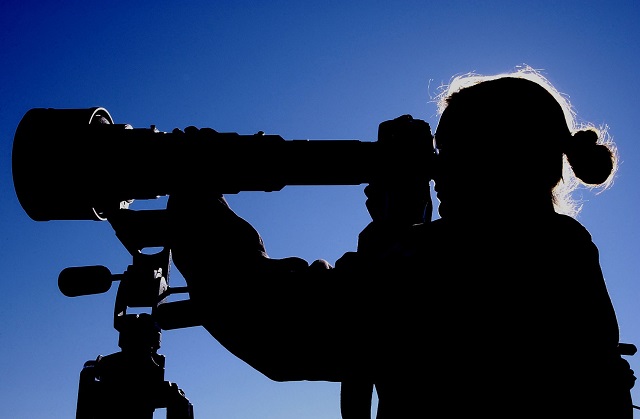
Are you fascinated by stars, comets, planets, and other celestial bodies you can glimpse in the night sky? Many aspiring astronomers start out at home, in their own backyard. It is possible to observe quite a lot about our solar system using basic telescopes or even the naked eye, but there are also many tools that can help you identify what you’re seeing and learn more about what’s out there.
The Basics of Astronomy
Astronomy is the study of celestial bodies throughout our universe. Our home, Earth, is just one planet in the solar system, and our sun at the center of the solar system is just one star of billions of others. Our solar system is part of the Milky Way galaxy, a collection of as many as 100 billion other solar systems. The Milky Way, in turn, is only one of at least 100 billion galaxies out there! Even the most sophisticated observation technology can see just a fraction of the celestial bodies that are out there. The Hubble Space Telescope, one of the most powerful telescopes created to date, can see up to 15 billion light years into space, but the universe is many times larger than that.
As an amateur astronomer, you won’t be able to see 15 billion light years into the night sky, but you can observe quite a lot. From your own home, it is possible to spot stars, planets, and even galaxies. You may even be lucky enough to spot asteroids or comets flying by. The key is knowing what you’re looking for.
Getting Started
You can get started right away, but depending on how far you would like to take your study of the universe beyond Earth, you may end up wanting some tools. Even without a telescope, you can observe quite a bit when you look up, though. Before you buy any astronomy equipment, go outside on as many clear nights as you can and just spend time getting to know the night sky. Where is the moon? How does it change relative to the position of the other stars you see each night? To get a better idea of what you could be looking at, you can reference constellation maps, astronomy guidebooks, or smartphone apps designed for the budding astronomer.
Once you have gotten a basic idea of what you’re looking at, you will probably be curious about what else you’ll be able to observe. The next step is to invest in a basic telescope or binoculars to extend your view farther beyond Earth. There are three main types of telescopes you can choose from: refracting, reflecting, or hybrid. Refracting telescopes use curved lenses. Reflecting telescopes use curved mirrors to minimize the refraction of light and extend the viewing distance. Hybrid telescopes use both technologies and combines their strengths. The quality of a telescope depends on the aperture, or diameter of the lens or mirror, and the optical quality, or how clear the image is. The greater the aperture, the more light a telescope can bring in and the higher resolution the image will have. Telescopes for home astronomers can range in price from around $500 to thousands of dollars.
- How Do Telescopes Work?
- What Do Telescopes Do?
- How to Become a Backyard Astronomer
- 10 Steps to Rewarding Stargazing
- Tips for Telescope Buying
The Constellations
Constellations are groups of stars that form images or patterns in the night sky. Many are named for mythological figures that the ancient Greeks and Romans thought they resembled. Stars in constellations aren’t often actually that close to each other and don’t have much in common other than the fact that they make up these pictures that humans imagined. Nevertheless, they are recognizable patterns that can help you gauge where you should be looking to find different things. They can also help us determine what season it is, as they are in different locations in the sky as Earth orbits the sun. While there used to be many different interpretations of what made up which constellations across cultures, they are now standardized into 88 official constellations. No one star belongs to more than one constellation. With the help of a sky atlas, you can spot many constellations from home even without a telescope.
- What Are Constellations?
- Using a Star Chart
- Finding Your Way Around the Sky
- Interactive Sky Map
- Map of the Constellations
The Solar System
Earth is the third of eight major planets orbiting the sun. Since we are on the inside, it is impossible to view the solar system as a whole, but we can observe quite a bit of it as Earth rotates and orbits around the sun. Five of the planets, Mercury, Venus, Mars, Jupiter, and Saturn, are visible from Earth for most of the year without a telescope. Their location changes as they and Earth move. In fact, that is the first step in identifying a planet: The planets will change location from night to night, while stars don’t change their location relative to each other in the sky. The window of time when a planet is visible from Earth is called an apparition. There are also other components of our solar system, like asteroids, comets, or meteors, that you may be able to spot occasionally. Meteors are frequently seen soaring across the night sky.
Famous Astronomers
Astronomy is not a new field of study; since the beginning of the human race, we have been looking up and wondering what else is out there. There have been many attempts to explain what we see and make sense of it. Several individuals have made groundbreaking scientific discoveries and observations of space, and those famous astronomers laid the foundation for more advanced space exploration in the present day.
Among the most famous astronomers are Nicolaus Copernicus, Galileo Galilei, Isaac Newton, Stephen Hawking, and Edwin Hubble. Copernicus first proposed the idea that the sun, rather than Earth, is the center of the universe. Galileo further advanced this theory and studied much about celestial bodies such as our sun and the moons of Jupiter. Newton helped formulate the theory of gravity, which serves as a backbone of studying how solar systems, galaxies, and the universe are held together. Hawking uncovered many mysteries surrounding black holes. Hubble, after whom the famous Hubble telescope is named, studied many galaxies beyond ours.
Space Exploration
Humans are continuing to discover more information about the cosmos today. Observation of the sky beyond Earth takes place with telescopes that are becoming more advanced, space probes that journey into the sky and visit planets or other celestial bodies, and manned rocket flights into space. Physical exploration of space had its beginning in the mid-20th century when Russia launched a satellite into Earth’s orbit and the United States landed a man on the moon. Future plans for space exploration include space tourism and manned missions to places beyond Earth’s orbit.
- Space Exploration and Astronauts
- Space Exploration: Astrobiology
- Astronomy Timeline
- Earth Observations From Space
Games and Activities for Students
If you’re interested in astronomy, you don’t have to wait until it’s dark out to explore the subject. There are plenty of games and activities that can help you learn more about what’s out there in the sky, both in and out of the classroom.
- Surfing the Solar System: A Treasure Hunt Game and Puzzle
- Modeling the Universe
- Group Activity: Constellations
- Build Your Own Telescope
- The Jovian Basketball Hoop
- Milky Way Activity
 Dining Room Sets
Dining Room Sets  Creating Cozy Spots for Cuddling
Creating Cozy Spots for Cuddling  Architectural Salvage
Architectural Salvage  Enhance Home Design with Decorative Leaded Glass
Enhance Home Design with Decorative Leaded Glass  Condo Renovation Considerations to Save Space
Condo Renovation Considerations to Save Space 

Are You Familiar With This Topic? Share Your Experience.